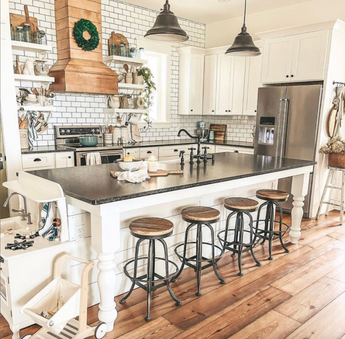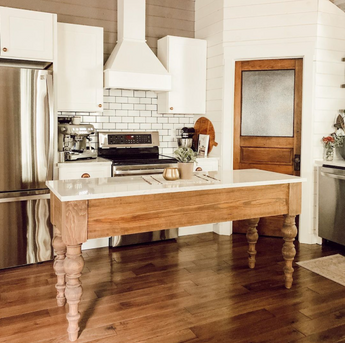Discovering the Essential Attributes of a Cooking Area Island Leg for Your Culinary Space
The kitchen area island serves as a main hub in any kind of culinary area, and the choice of leg layout is essential in enhancing both its capability and visual allure. Understanding the crucial functions of cooking area island legs-- including product options, style styles, and security variables-- can significantly affect the overall experience within the kitchen area.
Relevance of Kitchen Island Legs
Kitchen area island legs play an essential function in both the capability and looks of a cooking area space. They not only support the weight of the island however additionally enhance the general layout, adding to the kitchen's visual appeal. The option of legs can determine the design of the kitchen, be it modern-day, traditional, or rustic.
Functionally, robust and effectively developed legs make sure stability, permitting the risk-free usage of the island for numerous tasks such as food prep work, dining, or amusing. Strong legs avoid wobbling and moving, supplying a reliable surface area for day-to-day tasks.
In addition, the elevation and positioning of the legs can affect the convenience level for those seated at the island. A well-considered elevation can suit bar feceses or chairs, advertising a welcoming atmosphere for events.
Along with these useful considerations, kitchen island legs can act as a centerpiece in the room (kitchen island leg). Decorative or distinctly made legs can boost the style aesthetic, making the island a centerpiece. Thus, picking the ideal cooking area island legs is necessary for balancing form and function in any culinary space
Material Options for Legs
Picking the ideal product for cooking area island legs dramatically influences both toughness and style. Common product alternatives consist of stone, timber, and metal, each offering unique advantages.
Timber is a preferred option due to its heat and flexibility. It can be conveniently personalized to match various decoration styles, from rustic to modern. Hardwoods like oak and maple give exceptional strength and durability, while softer woods can be a lot more susceptible to tear and use.
Steel legs are favored for their streamlined, contemporary aesthetic. kitchen island leg. Stainless-steel and light weight aluminum are not just robust yet likewise resistant to corrosion and rust, making them optimal for kitchen settings. They can produce a commercial look and are typically readily available in numerous coatings to enhance other cooking area elements
Rock legs, such as granite or marble, add a component of luxury and security. While larger than other products, they offer exceptional resilience and can withstand considerable weight. They may need added support to guarantee correct equilibrium.
Eventually, the choice of product should straighten with both practical requirements and the total design vision of the kitchen area area, ensuring that the island legs boost both energy and looks.
Style Styles to Take Into Consideration
What design styles should be taken into consideration when selecting legs for a kitchen island? The selection of leg style dramatically influences the total aesthetic of your cooking space. For a modern kitchen, minimalistic and sleek leg styles, such as stainless-steel or geometric shapes, can improve the modern charm, providing a clean and minimalist look.
On the other hand, conventional cooking areas profit from traditional designs such as turned or sculpted wooden legs, which include heat and character. These choices often feature detailed details that match classic home furnishings. For a rustic ambiance, think about legs made from redeemed wood or wrought iron, which bring a natural, natural quality to the space.
If you lean in the direction of a commercial theme, robust steel legs with a troubled finish may be excellent, offering an edgy yet advanced touch. In addition, farmhouse style kitchens can integrate beefy legs that stimulate a feeling of sturdiness and homeliness.

Height and Security Factors
The height and security of a kitchen island are crucial components that directly affect its functionality and individual experience. An ideal kitchen area island leg need to offer enough height to fit a variety of jobs, from cooking to casual dining. Normally, kitchen islands separate 36 to 42 inches tall, lining up with typical counter and bar heights. This range guarantees convenience for customers while performing various activities, therefore improving the total use of the room.
Stability is equally important, specifically as kitchen islands typically offer as focal points in culinary settings. The leg's add-on to the island's base should be secure, guaranteeing long life and durability against the wear and tear of everyday usage.
Personalization and Devices
Modification choices and devices for cooking area island legs can dramatically improve both the visual charm and capability of the space. Home owners can select from a selection of materials, consisting of metal, wood, and rock, enabling for seamless combination with existing cooking area design. The selection of finish-- be it a natural tarnish, paint, or powder finish-- further customizes the appearance, ensuring that the island matches the total layout pop over here theme.
Along with product and finish, property owners might additionally check out the incorporation of accessories such as ornamental braces, flexible feet, or incorporated shelving. Braces can provide extra assistance while adding to a modern or rustic aesthetic. Adjustable feet are especially valuable for uneven flooring, guaranteeing the island stays steady and degree, which is critical for both safety and usability.

Verdict
In final thought, kitchen area island legs offer an important duty in providing stability and improving the total aesthetic of the culinary room. The selection of materials and style styles adds to both functionality and visual charm, while factors to consider of elevation and security make certain practical use. Personalization choices and devices can raise the kitchen area island, making have a peek here it an unique focal factor within the home. Therefore, cautious consideration of these functions is necessary for a reliable cooking area layout.
The kitchen area island serves as a central center in any kind of culinary space, and the selection of leg layout is essential in improving both its functionality and aesthetic charm. Comprehending the essential attributes of cooking area island legs-- including material alternatives, style styles, and stability factors-- can dramatically affect the overall experience within the kitchen.Cooking area island legs play an important role in both the capability and aesthetic appeals of a kitchen room.What style styles should be considered when selecting legs for a kitchen area island?In final thought, cooking area island legs serve a crucial duty in supplying stability and discover this info here boosting the general visual of the cooking space.